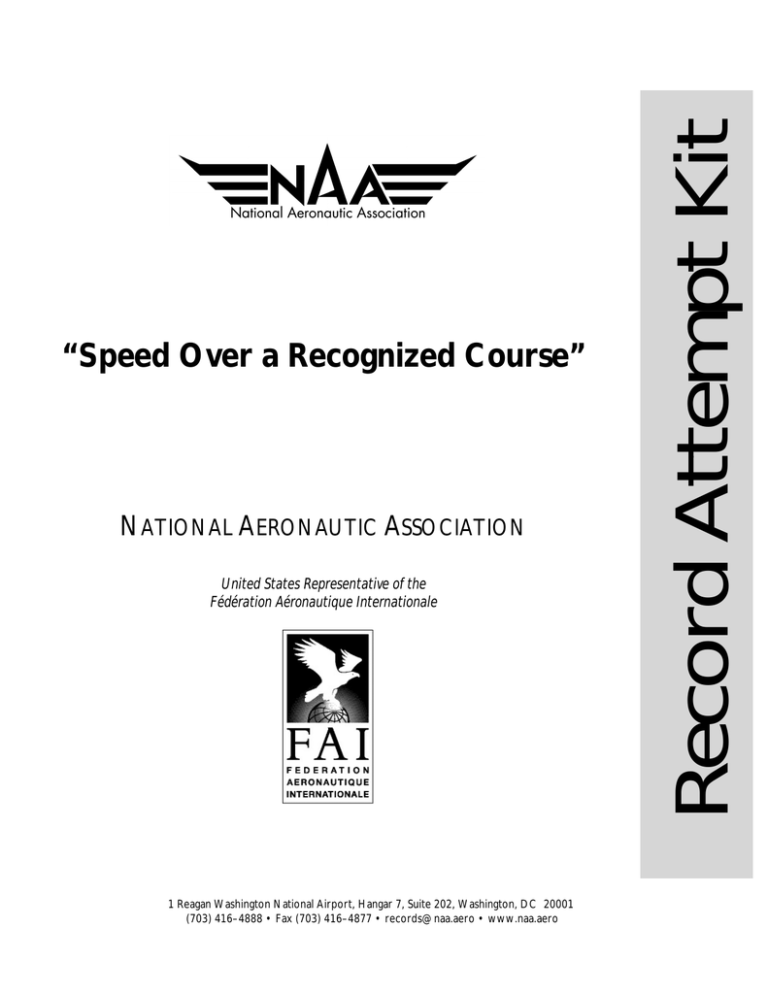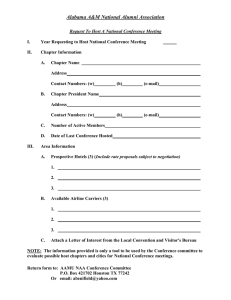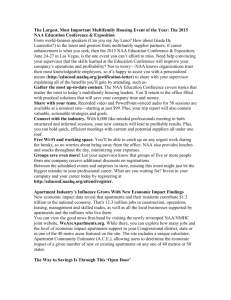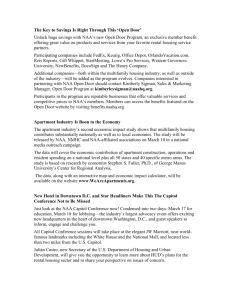Speed Over a Recognized Course - National Aeronautic Association
advertisement

NATIONAL AERONAUTIC ASSOCIATION United States Representative of the Fédération Aéronautique Internationale 1 Reagan Washington National Airport, Hangar 7, Suite 202, Washington, DC 20001 (703) 416–4888 • Fax (703) 416–4877 • records@naa.aero • www.naa.aero Record Attempt Kit “Speed Over a Recognized Course” Preface The National Aeronautic Association is the National Aero Club of the United States. It traces its roots back to 1905 when the Aero Club of America was founded. It is the nation's oldest aviation organization. Since its beginning, NAA's primary mission has been the advancement of the art, sport and science of aviation in the United States. In recent years, its mission has been broadened to include space flight. NAA was a founding member of the Fédération Aéronautique Internationale (FAI) and has remained as a member since 1905. FAI is the international organization responsible for the coordination of air sports, competition, and certification of all aviation and space records in the world. NAA, as the U.S. representative of FAI, is responsible for coordination and certification of all aviation and space records originating in the United States. The founders of The Aero Club of America concluded very early that one of the most effective ways to encourage the advancement of the art, sport, and science of aviation was through competition. Competition encouraged individuals and organizations to push the science of aeronautics to the limit of existing technology. This is as true today as it was in the early days of aviation. For many years, Orville Wright was chairman of NAA's Contest and Records Board. He encouraged pilots of all levels of experience to compete and set records. It is in this spirit that we encourage all pilots to seek out and to set records, whether in a Piper Cub or in a Boeing 777 on a scheduled international flight. National Aeronautic Association 1 Reagan Washington National Airport Hangar 7, Suite 202 Washington, DC 20001 Phone: Fax: E-mail: Web: (703) 416–4888 (703) 416–4877 records@naa.aero www.naa.aero RECORD ATTEMPT KIT Table of Contents Records for “Speed Over a Recognized Course”. . . . . . . . . . . . . . . . . . . . . . . . . . . . . . . . . . . . . . . . . Introduction. . . . . . . . . . . . . . . . . . . . . . . . . . . . . . . . . . . . . . . . . . . . . . . . . . . . . . . . . . . . . . . Record Description and Requirements.. . . . . . . . . . . . . . . . . . . . . . . . . . . . . . . . . . . . . . . . . . Aircraft Classifications. . . . . . . . . . . . . . . . . . . . . . . . . . . . . . . . . . . . . . . . . . . . . . . . . . . . . . . . Special Rules for Rotorcraft.. . . . . . . . . . . . . . . . . . . . . . . . . . . . . . . . . . . . . . . . . . . . . . . . . . . Special Rules for Jetlift Aeroplanes. . . . . . . . . . . . . . . . . . . . . . . . . . . . . . . . . . . . . . . . . . . . . . Special Rules for Microlights. . . . . . . . . . . . . . . . . . . . . . . . . . . . . . . . . . . . . . . . . . . . . . . . . . . Special Rules for Very Light Jets. . . . . . . . . . . . . . . . . . . . . . . . . . . . . . . . . . . . . . . . . . . . . . . . Transcontinental Speed Records. . . . . . . . . . . . . . . . . . . . . . . . . . . . . . . . . . . . . . . . . . . . . . . Sanctions. . . . . . . . . . . . . . . . . . . . . . . . . . . . . . . . . . . . . . . . . . . . . . . . . . . . . . . . . . . . . . . . . . Sanction, Registration, and Other Fees.. . . . . . . . . . . . . . . . . . . . . . . . . . . . . . . . . . . . . . . . . . Membership and Sporting License Requirements. . . . . . . . . . . . . . . . . . . . . . . . . . . . . . . . . . Official Observers. . . . . . . . . . . . . . . . . . . . . . . . . . . . . . . . . . . . . . . . . . . . . . . . . . . . . . . . . . . Margin Over an Existing Record. . . . . . . . . . . . . . . . . . . . . . . . . . . . . . . . . . . . . . . . . . . . . . . . Notification to NAA. . . . . . . . . . . . . . . . . . . . . . . . . . . . . . . . . . . . . . . . . . . . . . . . . . . . . . . . . Submission of Documentation to NAA.. . . . . . . . . . . . . . . . . . . . . . . . . . . . . . . . . . . . . . . . . . National Records versus World Records. . . . . . . . . . . . . . . . . . . . . . . . . . . . . . . . . . . . . . . . . Record Holder Merchandise.. . . . . . . . . . . . . . . . . . . . . . . . . . . . . . . . . . . . . . . . . . . . . . . . . . Photographs and Social Media Information.. . . . . . . . . . . . . . . . . . . . . . . . . . . . . . . . . . . . . . . Other Questions. . . . . . . . . . . . . . . . . . . . . . . . . . . . . . . . . . . . . . . . . . . . . . . . . . . . . . . . . . . . 2 2 2 2 3 4 4 4 4 5 5 5 5 6 6 6 6 6 6 6 Requirements for Documenting Record Attempts. . . . . . . . . . . . . . . . . . . . . . . . . . . . . . . . . . . . . . . . Start Time of the Attempt. . . . . . . . . . . . . . . . . . . . . . . . . . . . . . . . . . . . . . . . . . . . . . . . . . . . Finish Time of the Attempt.. . . . . . . . . . . . . . . . . . . . . . . . . . . . . . . . . . . . . . . . . . . . . . . . . . . Weight of the Aircraft. . . . . . . . . . . . . . . . . . . . . . . . . . . . . . . . . . . . . . . . . . . . . . . . . . . . . . . . Other Information.. . . . . . . . . . . . . . . . . . . . . . . . . . . . . . . . . . . . . . . . . . . . . . . . . . . . . . . . . . 7 7 7 8 8 Checklist for Claiming a Record.. . . . . . . . . . . . . . . . . . . . . . . . . . . . . . . . . . . . . . . . . . . . . . . . . . . . . . 9 NAA Mission Statement.. . . . . . . . . . . . . . . . . . . . . . . . . . . . . . . . . . . . . . . . . . . . . . . . . . . . . . . . . . . 10 1 Records for “Speed Over a Recognized Course” Introduction The National Aeronautic Association, as the United States representative of the Fédération Aéronautique Internationale, is the sole authority within the U.S. for certifying aviation and space records. All official attempts of National and World records must be made in accordance with the Sporting Code of FAI, the world authority for the certification of international records. While the Sporting Code outlines the specific rules and requirements for each record class, the procedures in this kit generally apply to all record attempts sanctioned by NAA. Record Description and Requirements “Speed Over a Recognized Course” records represent the fastest certified speed of an aircraft flying between two cities or geographical features. Records may be flown between any cities or geographic features designated for that purpose, and any time spent on the ground counts as flying time. The minimum distance between the start and finish points for airplane World records is 400 kilometers (249 statute miles). The minimum distance has been reduced to 200 kilometers (125 statute miles) for U.S. National records. The great circle distance between the start and finish points is used to calculate the certified speed, regardless of the route of flight. For airplanes, the start and finish points must be located within 60 kilometers (38 statute miles) of the city or town centers. However, the distance between the start point and finish point shall not be less than 98% of the distance between the city centers. Prior to the attempt, NAA will confirm the names of the cities listed in the record title. To qualify as a record, the certified speed must be equal to or greater than the minimum steady flight speed (stall speed with flaps up / Vs) of the aircraft. If the minimum steady flight speed is unknown, the certified speed must be equal to or greater than 100 kmh (62 mph). Aircraft Classifications The following classifications of aircraft are used for “Speed Over a Recognized Course” records: Class C: Class E: Class H: Class R: Class VLJ: Landplane (C-1), Seaplane (C-2), Amphibian (C-3) Rotorcraft (Helicopters, Tilt Rotors, and Autogyros) Jetlift Aeroplanes Microlights Very Light Jets Class C is further divided into separate groups, depending on type of engine: Group I. . . . . Internal Combustion Group II. . . . Turboprop Group III. . . . Jet Group IV Group V Group VI 2 Rocket (and Rocket assisted) Scramjet Electric To encourage competition among similar aircraft, most classes are divided into subclasses, based on actual takeoff weight. The following table lists the classifications for records in Class C (these are approximate weights, based on metric conversions): Classes C-1 (Landplanes), C-2 (Seaplanes) and Class C-3 (Amphibians) Weight classification Takeoff Weight Range (in pounds) C-1.a/0 C-1.a C-1.b C-1.c C-1.d C-1.e C-1.f C-1.g C-1.h C-1.i C-1.j C-1.k C-1.l C-1.m C-1.n C-1.o C-1.p C-1.q C-1.r C-1.s C-1.t C-1.u < 661 661 < 1,102 1,102 < 2,205 2,205 < 3,858 3,858 < 6,614 6,614 < 13,228 13,228 < 19,842 19,842 < 26,455 26,455 < 35,274 35,274 < 44,092 44,092 < 55,116 55,116 < 77,162 77,162 < 99,208 99,208 < 132,277 132,277 < 176,370 176,370 < 220,462 220,462 < 330,693 330,693 < 440,924 440,924 < 551,155 551,155 < 661,386 661,386 < 881,849 881,849 < 1,102,310 C-1.v > _ 1,102,310 Special Rules for Rotorcraft For World and U.S. National records in Class E (Rotorcraft) that start and finish within the same country, the distance must be at least 250 kilometers (156 statute miles). Generally, the start and finish points must be located within 20 kilometers (13 statute miles) of the city or town centers. 3 Class E-1 (Helicopters) and Class E-3 (Autogyros) Subclass designation E-1.a and E-3.a E-1.b and E-3.b E-1.c and E-3.c E-1.d and E-3.d E-1.e E-1.f E-1.g E-1.h E-1.i E-1.j E-1.k E-1.l Gross Takeoff Weight Range (in pounds) < 1,102 1,102 < 2,205 2,205 < 3,858 3,858 < 6,614 6,614 < 9,921 9,921 < 13,228 13,228 < 22,046 22,046 < 44,092 44,092 < 66,139 66,139 < 88,185 88,185 < 110,231 > _ 110,231 Special Rules for Jetlift Aeroplanes Special rules apply to records in Class H (Jetlift Aeroplanes). Please contact NAA for details if you are planning a record attempt in this class. Special Rules for Microlights U.S. National records for "Speed Over a Recognized Course" may be set in Class R (Microlights). However, FAI does not recognize these as World records. The minimum distance between the start and finish points for Microlight records is 125 kilometers (78 statute miles). The start time shall be the time of takeoff and the finish time shall be the time of landing (airborne starts and finishes are not allowed). There is no minimum speed requirement for certification of the record. All vehicles must meet the definition of a Microlight found in Section 10 of the FAI Sporting Code. For the purposes of "Speed Over a Recognized Course" records, all classes of Microlights will compete in the same class. Special Rules for Very Light Jets U.S. National records for "Speed Over a Recognized Course" may be set in Class VLJ (Very Light Jets). Aircraft competing in this class must be turbojet powered airplanes with a maximum gross takeoff weight of 10,000 pounds or less; hold a standard airworthiness certificate (if a standard airworthiness certificate has not yet been issued, the manufacturer must provide evidence of having submitted an application to FAA for type certification); be capable of carrying 4 or more passengers; and have no temporary performance additions, modifications, or STC's. (i.e. ferry tanks). It may also be possible to also claim records concurrently in Class C for World record recognition. Transcontinental Speed Records Record attempts that start and finish within 60 kilometers (20 kilometers for rotorcraft) of the Atlantic and Pacific coastlines may be eligible for U.S. National Transcontinental Speed Records. Records are available for eastbound, westbound, and round trip flights. 4 Sanctions A contestant must apply to NAA for a sanction prior to the flight. A sanction is valid for 90 days (or until the record is claimed), unless otherwise noted. It gives the contestant exclusive rights within the U.S. to attempt the record during the sanction period. If requested in writing, the sanction period may be extended an additional 30 days. The sanction application and related fee should be submitted to NAA 21 days before the date of the record attempt. The contestant and sponsor must agree to hold NAA harmless and to indemnify NAA and its officers, agents, directors, and employees from any expense, losses, or damages as a result of claims or action that might be brought as a result of the record attempt. Sanctions will only be granted to contestants who hold a valid FAA pilot certificate (except a student pilot certificate) or military aeronautical rating for the type of vehicle being flown. Sanctions will not be granted for any flight that would violate applicable Federal Aviation Regulations unless a waiver is first obtained from the FAA permitting such operations. Sanction, Registration, and Other Fees Sanction fees must accompany the sanction application and are non-refundable. Registration fees are due at the time a record is claimed and must be submitted with the Record Claim Statement (Form S). NAA will not process a record claim before receiving full payment. See the current NAA fee schedule for sanction, registration, and other fees. Please note the reduced rates for the second and subsequent records set on the same flight or within 30 days thereof. For the first record, the registration fee includes one mounted NAA National certificate and one mounted FAI diploma (if appropriate) for the applicant. For the second and each additional record, the registration fee includes one unmounted NAA National certificate and one unmounted FAI diploma (if appropriate) for the applicant. Membership and Sporting License Requirements Contestants must apply for NAA membership and an FAI Sporting License at least 14 days prior to attempting a record. Both applications can completed online at: http://naa.aero/membership/membership-application The sporting license is available to U.S. citizens and residents through NAA, and is valid for 12 months. While it is not a requirement that all flight crew members participate in the record attempt, those who do wish to be officially recognized must also satisfy the membership and sporting license requirements, and be properly rated in the aircraft being flown. Official Observers Normally, on-duty FAA Air Traffic Controllers (and their foreign or military equivalents) can serve as Official Observers for your record attempt. Where it is not possible to utilize ATC personnel, the Official Observers must be designated in advance by NAA to serve in this capacity. A record attempt can only be conducted after the Official Observers have found the arrangements to be satisfactory. Official Observers have the authority to discontinue a record attempt any time they are not satisfied with the conditions surrounding the attempt, including questions relating to the weather, safety, pilot competency, or lack of control over the flight. Record attempts that violate Federal Aviation Regulations will not be certified. 5 Margin Over an Existing Record For a speed record to be certified, the performance must better the existing record by 1%. Notification to NAA The contestant must notify NAA in writing of each new record claim within 72 hours of the attempt. The preliminary results of the attempt, including the date and estimated performance, must be provided. This notification must be made in by e-mail or through the NAA web site. Whenever appropriate, NAA will then notify FAI of the preliminary results. You must also telephone NAA at (703) 416-4888 within 24 hours of submitting your claim to confirm that it was received. See "Checklist for Claiming a Record" on page 9 for more information. Submission of Documentation to NAA Within 30 days of the record attempt, complete documentation on the flight must be forwarded to NAA. It is the responsibility of the contestant to ensure that all the required documentation is sent to NAA. In most instances, the documentation will be forwarded directly to NAA by the Official Observers. All documentation submitted becomes the property of NAA (for U.S. National records) and FAI (for World records). National Records versus World Records United States "National" records are approved by the National Aeronautic Association. "World" records are approved by the Fédération Aéronautique Internationale. Under FAI rules, a potential World record must first be certified as a National record. Once NAA has approved the record claim as a National record, NAA will issue a certificate and, if a World record is also being claimed, forward the documentation to FAI. Generally, once the completed paperwork has been submitted to NAA, it takes approximately 30 days for NAA to approve the claim as a National record. It then takes FAI an additional 30-60 days to review and approve the claim as a World record. Record Holder Merchandise NAA offers a variety of record holder merchandise. Please go to www.naa.aero for more details and information on placing an order. Photographs and Social Media Information NAA encourages the inclusion of photographs of the aircraft and crew when submitting record documentation. The photos will become a historical part of the record file, and may be used for publicity purposes. NAA uses social media to publicize records and relay other news of interest to our members. You can follow us on Twitter (@NatlAero) for instant updates. Other Questions This abbreviated guide cannot attempt to answer all questions that may arise. Please contact NAA for further information. 6 Requirements for Documenting Record Attempts Record attempts for “Speed Over a Recognized Course” must be documented as described below. The forms are available for download at NAA’s web site (http://www.naa.aero). Certificates Required Reasons for Documentation Certification of Takeoff (Form 1) To certify the start time of the attempt or Certification of Time Crossing Fix (Form 2) Certification of Landing (Form 7) To certify the finish time of the attempt or Certification of Time Crossing Fix (Form 2) Certification of Weight (Form 10) To certify the weight of the aircraft Record Claim Statement (Form S) To provide other details of the attempt Start Time of the Attempt 1. Certification of Takeoff (Form 1) signed by FAA Air Traffic Control personnel (or their foreign or military equivalent) or an NAA Official Observer1. The form must be given to the appropriate person before the start of the attempt and mailed directly to NAA by the signatory. or 2. Certification of Time Crossing Fix (Form 2)2 indicating the time of passage over the airport, navigational aid, or other acceptable fix, signed by FAA Air Traffic Control personnel (or their foreign or military equivalent) or an NAA Official Observer1. This requires advance communication and coordination. The form must be mailed directly to NAA by the signatory. Finish Time of the Attempt 1. Certification of Landing (Form 7)3 signed by FAA Air Traffic Control personnel (or their foreign or military equivalent) or an NAA Official Observer1. The form must be given to the appropriate person before the start of the attempt and mailed directly to NAA by the signatory. or 2. Certification of Time Crossing Fix (Form 2)2, 3 indicating the time of passage over the airport, navigational aid, or other acceptable fix, signed by FAA Air Traffic Control personnel (or their foreign or military equivalent) or an NAA Official Observer1. This requires advance communication and coordination. The form must be mailed directly to NAA by the signatory. 1 Official Observers must be designated in advance by NAA to serve in this capacity. Failure to adhere to this requirement will result in rejection of the certification. 2 Unless the aircraft can be visually identified at a low altitude, it will be necessary to establish the exact time over the fix through radar observation. 3 Fifty-nine seconds will be added to the elapsed time when the Certification of Landing or Certification of Time Crossing Fix does not indicate time to the nearest second. 7 Weight of the Aircraft 1. 2. Production Aircraft with Standard Fuel Tanks: a. Photocopy of Airplane Flight Manual showing the maximum certified takeoff weight and standard fuel tank size; b. Copy of most recent FAA Form 337 (or other official weight and balance documentation) showing actual empty weight; c. Certification of Weight (Form 10) completed by the pilot. Production Aircraft with Nonstandard Fuel Tanks; and Nonproduction Aircraft: Contact NAA to discuss the requirements for your particular aircraft. Other Information At the completion of the flight, the Record Claim Statement (Form S) must be prepared by the NAA Official Observer, or by the pilot making the record attempt. The completed form, registration fee, and any additional documentation must be submitted to NAA no later than 30 days from the date of the record attempt. 8 Checklist for Claiming a Record G Contact NAA in writing within 72 hours of the flight to claim your record. Use one of the following methods: G Website.. . . . . . . . . . . . . . . . . . . . . www.naa.aero G E-mail. . . . . . . . . . . . . . . . . . . . . . . records@naa.aero Provide the following details of the flight: a) b) c) d) e) f) name of pilot; names of any additional flight crew members; start / finish points (including cities); date of the flight; aircraft make and model; estimated ground speed. G Within 24 hours of making your written claim, telephone NAA at (703) 416-4888 to confirm that your claim was received. G Within 30 days, be sure NAA has been sent complete details of the flight as follows: G Record Claim Statement (Form S) G Certificate of Takeoff (Form 1) or Certificate of Time Crossing Fix (Form 2) G Certificate of Landing (Form 7) or Certificate of Time Crossing Fix (Form 2) G Certificate of Weight (Form 10), plus supporting documentation (see page 9) G Payment (check, money order, or credit card [American Express, Discover, MasterCard, or Visa] ) for registration fees and any other fees After NAA receives and reviews the documentation file, NAA may certify the record as a United States National record. If a World record is being claimed, NAA will forward a complete dossier to FAI in Switzerland requesting that FAI approve the record as a World record. It usually takes FAI 90-120 days to approve the record, or to request additional documentation. NAA hosts awards ceremonies periodically to present record setters their certificates and publicly recognize their accomplishments. You may request to have NAA present certificates during other events, as well. If you prefer, the certificates can be shipped to you. Congratulations! You have become an official part of aviation history! 9 03/2015 NATIONAL AERONAUTIC ASSOCIATION MISSION STATEMENT The National Aeronautic Association is the National Aero Club of the United States. Its primary mission is the advancement of the art, sport, and science of aviation and space flight by fostering opportunities to participate fully in aviation activities and by promoting public understanding of the importance of aviation and space flight to the United States. In carrying out this mission, NAA, as the National Aero Club of the United States, will: Develop opportunities to strengthen the mutual objectives of NAA and its corporate members, air sport organizations, chapters and affiliates, including the formation of affiliated aero clubs in U.S. cities where such organizations do not now exist; Represent United States aviation throughout the world as a member of the Fédération Aéronautique Internationale; Encourage, coordinate, document, and promote competition and record-making aviation and space events in accordance with the rules prescribed by the Fédération Aéronautique Internationale, of which NAA is the official U.S. representative; Recognize and reward those who make outstanding contributions to the advancement of aviation and space flight through presentations of awards and other honors; Endorse sound national programs and other efforts designed to help the United States remain a leader in aviation and space flight; Support and encourage aviation and space education programs; Promote and encourage public participation in, and appreciation of, U.S. aviation and space activities.






